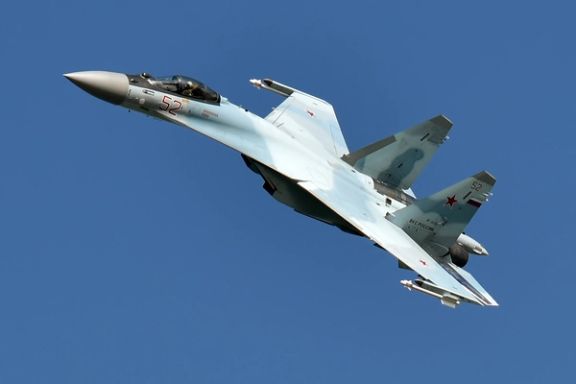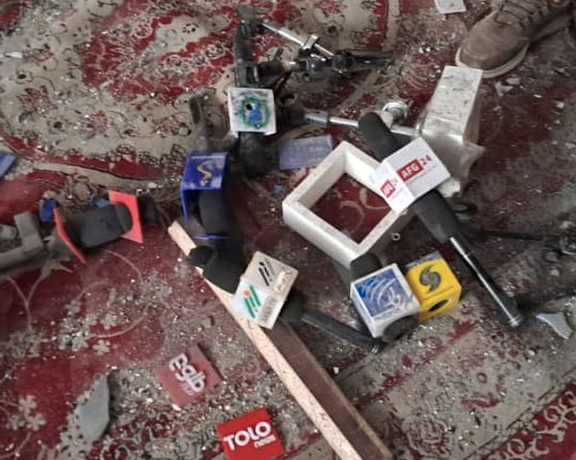Iran To Buy Su-35 Warplanes From Russia - Iranian Broadcaster

Iran has reached a deal to buy advanced Su-35 fighter planes from Russia, Iranian state media says, expanding its controversial military ties with Moscow.

Iran has reached a deal to buy advanced Su-35 fighter planes from Russia, Iranian state media says, expanding its controversial military ties with Moscow.
"The Sukhoi-35 fighter planes are technically acceptable to Iran and Iran has finalized a contract for their purchase," the broadcaster IRIB quoted Iran's mission to the United Nations as saying in New York.
The report did not carry any Russian confirmation of the deal, details of which were not disclosed. The mission said Iran had also inquired about buying military aircraft from several other, unnamed countries, IRIB reported.
Russian President Vladimir Putin met Iranian Supreme Leader Ayatollah Ali Khamenei in Tehran last July, stressing closer ties in the face of Western pressure over the war in Ukraine.
Iran has has supplied hundreds of kamikaze drones to Russia that have been used to target Ukraine's military and civilian infrastructure. Moscow denies that its forces use Iranian-built drones in Ukraine, although many have been shot down and recovered there.
Iran’s air force has only a few dozen strike aircraft: Russian jets as well as ageing US models acquired before the Iranian revolution of 1979. Instead, Iran has developed a variety of drones and missiles see n as a threat for other regional countries.
In 2018, Iran said it had started production of the locally designed Kowsar fighter for use in its air force. Some military experts believe the jet is a carbon copy of an F-5 first produced in the United States in the 1960s.
With reporting by Reuters

A bomb explosion in a cultural center affiliated with the Islamic Republic in Afghanistan has left at least four people dead and several others injured.
Abdul Nafi Takor, the spokesman of the Taliban's Ministry of Interior said Saturday that the bomb was planted in the "Tebyan" center supported by the Islamic Republic of Iran in the northern city of Mazar-i-Sharif.
German news media say a member of security forces was killed and eight people, including five journalists and three children are among the wounded.
Meanwhile, Radio Azadi, the Afghan Service of Radio Free Europe, quoted local sources as saying that the explosion left four people dead and 16 wounded.
According to reports, provincial journalists were supposed to be receive awards in Tebyan Cultural Center on Saturday.
A large number of media activists and religious figures were also present in this ceremony.
The bombing in the Shia center on Saturday came two days after ISIS claimed a suicide attack on the office of the Taliban governor in Balkh province that killed the governor of Mazar-i-Sharif Mohammad Dawood Muzammil.
The Tebyan Center is one of the cultural centers supported by the Islamic Republic that one of its branches was attacked by the Islamic State group in Kabul in 2017.
Iran developed religious and other foundations in Afghanistan to build influence during the US presence in the country. Its relations with the Taliban are a mixture of cooperation and tensions.

A high-ranking seminarian in Qom, Iran's most religious city says there is a strange tendency among members of the Bakhtiari tribe to convert to Zoroastrianism.
Speaking in an interview with Didban Iran [Iran Monitor] website, Ayatollah Seyyed Mohammad-Javad Alavi-Boroujerdi who teaches jurisprudence and principles of Shiism at the Qom Seminary, added that there are home-based churches in Qom for Muslims who have converted to Christianity.
Converting to another religion is forbidden in Islam and Iran's government does not allow or recognize conversion.
Presenting further evidence about Iranian youths abandoning Shiism, Boroujerdi said that some people in Qom are converting to Budhism. "The number of Wahabi Muslims in Iran is also on the rise. They have increased their activities and have their own Friday Prayer congregations," Said Boroujerdi.
He criticized Iranian hardliners for violent methods to make people stick to strict Shiite religious rules and said we cannot divide people into insiders and outsiders and then tell the outsiders to leave the country.
Boroujerdi warned that "some Iranians including the Bakhtiaris are separating from us, and that is a problem." He added: "These are the people who used to be with us. Let us be friends with the people and maintain our communication with them," he advised regime officials.
"I feel responsible for the youngsters who have left us and became Christian. He is a Shite boy and I must bring him back into the fold. I cannot let him go."

The scholar added that the 12th Imam of the Shiites went into the occult because a divide occurred among the people after the 11th Imam's death and the people at the time did not embrace the 12th Imam's leadership." Meanwhile, he stressed that "people including state officials who promise the hidden Imam's imminent return are liars. He will emerge only when Allah wants him to emerge from the occult."
Boroujerdi regretted that young clerics who start their career at the seminary in all honesty and modesty, gradually do away with these traits and may only try to return to them when they are too old. He asked: "What have we done to young Shiites who fought a war for us and are still enduring the sanctions?"
Other clerics and commentators have also said that Iranian youth have turned their back to Shiism. Conservative website Alef in Iran wrote last April that "the presence of religion as part of the government has led to a decline in religious beliefs."
The website added, "the experience of the Islamic Republic in Iran showed that political religion, i.e., clerics’ presence in political positions and in the government has led to a decline in the people's religious beliefs."
The report further added that Iranians were more religious under the Shah than in the Islamic Republic where clerics are holding political power. Iranian clerics' social status declined further during more than five months of street protests against the government, as people came out to demand a secular government with no clerics in key positions.
Reports on the Qom Seminary's own website indicate that clerics and government officials knew since more than ten years ago that Iranian youths have turned their backs to religion.
Meanwhile, media reports indicate that even Supreme Leader Ali Khamenei knows that Iranians demand a secular government and that the youths are turning away from his religious government.
Nonetheless, some clerics and Muslim scholars maintain that young Iranians are only weary of the version of religion that treats them in a dogmatic and unilateral way. They are fed up with the paradoxes that we feed them. otherwise, they are not against the essence of religion."

Iran’s battered currency, rial, rose more than 10 percent on Saturday following an agreement announced Friday to restore diplomatic relations with Saudi Arabia.
The rial has risen 25 percent since February 26 when it dropped to a historic low of 600,000 to the US dollar. A visit by the head of the UN nuclear watchdog, the IAEA, to Tehran on March 4 helped the rial rally, seen as a possible opening to resolve the country’s nuclear dispute with the United States.
The restoration of ties with Saudi Arabia provided another significant boost.
The rial traded at around 450,000 to the dollar Saturday, as the representative of currency exchange dealers in Tehran claimed that demand for dollars “has dropped to zero.”
Iran’s currency began losing value when for US President Donald Trump decided to withdraw from the Obama-era nuclear deal, the JCPOA, in 2018. By August 2022, the rial stood at 300,000 to the dollar, a nine-fold drop since Trump’s decision.
After Biden administration nuclear talks with Tehran reached a deadlock in September, the rial began to fall again reaching its lowest point in late February.
Hope about a possible foreign policy shift to help end Iran’s isolation immediately impacts rial’s value. An agreement with the United States would lift crippling economic sanctions, allowing Iran to export more oil at higher prices and gain hard currency revenues it needs for imports.

Kaspersky security firm says that among the countries of the Middle East and Africa, Iran is at the top of the list of countries affected by digital stalking.
Stalkerware is a commercially available software that can be installed on smartphone devices, enabling perpetrators to monitor an individual’s private life without their knowledge.
According to the company's annual report, a total of 1,754 people has been victim of stalking in Iran in 2022. It also adds that the total number of victims of digital stalking in the world in 2022 was 29,312; a number that shows a relative decrease compared to the year before.
The data covers the affected number of Kaspersky users, with the total global number of affected individuals likely to be much higher.
The "Coalition Against Stalkerware" organization estimates the number of victims of these spyware programs to be around one million every year.
Stalkerware can be downloaded and easily installed by anyone with an Internet connection. A perpetrator can use the software to monitor huge volumes of personal data and check device location, text messages, social media chats, photos, browser history and more.
Russia has the highest number of victims of spyware in the world with 8,281 cases, followed by Brazil with 4,969 and India with 1,807 victims.
In this way, Iran is the fourth country with the most victims of spyware in the world.

Reports from Iran say two police officers have been gunned down in Iran's protest-hit southeastern province of Sistan and Baluchestan.
The attack occurred in a region called Golshan on Friday. However, no information has been published about the identity of the assailants, their possible arrest or their motives.
Local media identified the two officers as Mohsen Pudinei and Ehsan Shahraki who were shot "while carrying out a security mission regarding Friday prayers".
The government has been trying to contain protests in the province on Fridays following weekly prayers.
State news agencies say the attack was carried out by “armed thugs”. The term is a vague description that officials use to refer to armed people affiliated with political groups opposed to the regime and sometimes drug traffickers.
After the "Bloody Friday" of Zahedan, the cities of Sistan and Baluchistan have been the scene of massive street protests every Friday after prayers.
The Bloody Friday in Zahedan, the provincial capital of Sistan-Baluchestan took place September 30, when security forces killed at least 93 people, and injured hundreds more during antigovernment protests.
No one has been arrested and prosecuted for shooting protesters in the province.
In recent months, pressure on the people of Sistan-Baluchistan has increased, and the situation in various cities has been described as very tense, especially on Fridays.
Amid tensions, the commander of the police force of this province was changed on February 27 for the second time since the beginning of the protests following the death of Mahsa Amini in police custody.